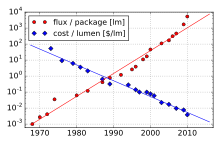Haitz's law

Haitz's law is an observation and forecast about the steady improvement, over many years, of light-emitting diodes (LEDs).
It claims that every decade, the cost per lumen (unit of useful light emitted) falls by a factor of 10, and the amount of light generated per LED package increases by a factor of 20, for a given wavelength (color) of light. It is considered the LED counterpart to Moore's law, which states that the number of transistors in a given integrated circuit doubles every 18 to 24 months.[1] Both laws rely on the process optimization of the production of semiconductor devices.
Haitz's law is named after Roland Haitz (1935–2015),[2] a scientist at Agilent Technologies among others. It was first presented to the larger public at Strategies in Light 2000, the first of a series of annual conferences organized by Strategies Unlimited.[3] Besides the forecast of exponential development of cost per lumen and amount of light per package, the publication also forecast that the luminous efficacy of LED-based lighting could reach 200 lm/W (lumen per Watt) in 2020, crossing 100 lm/W in 2010. This would be the case if enough industrial and government resources were spent for research on LED-lighting. More than 50% of the electricity consumption for lighting (20% of the totally consumed electrical energy) would be saved reaching 200 lm/W. This prospect and other stepping-stone applications of LEDs (e.g. mobile phone flash and LCD-backlighting) led to a massive investment in LED-research so that the LED efficacy did indeed cross 100 lm/W in 2010. If this trend continues, LEDs will become the most efficient light source by 2020.
The theoretical maximum for a continuous wavelength (as opposed to one made up of a combination of discrete-wavelength sources) white light source (at 5800K colour temperature with wavelengths restricted to the visible band of between 400nm and 700nm) is 251 lm/W.[4] However, some non-continuous wavelength composite "white" LEDs have achieved efficacies of over 300 lm/W.[5][6]
In 2010, Cree Inc., developed and marketed the XM-L LED that claimed 1000 lumens at 100 lm/W efficacy and 160 lm/W at 350 mA and 150 lm/W at 700 mA.[7] They also claimed to have broken the 200 lm/W barrier in R&D with a prototype producing 208 lm at 350 mA.[8] In May 2011, Cree announced another prototype with 231 lm/W efficacy at 350 mA.[9] In March 2014, Cree announced another prototype with a record-breaking 303 lm/W efficacy at 350 mA.[5]
In 2017, Philips Lighting started offering consumer LED lights with 200 lm/W efficacy in Dubai[10] using LED filament technology, three years before what Haitz's law predicted.
References[]
- ^ "Haitz's law". Nature Photonics. 1: 23. 2007. doi:10.1038/nphoton.2006.78.
- ^ Wright, Maury. "In Tribute: Recognizing the life and work of LED pioneer Roland Haitz". ledsmagazine.com. Retrieved 19 August 2015.
- ^ Haitz, R.; Tsao, J. Y. (2011). "Solid-state lighting: 'The case' 10 years after and future prospects". Phys. Status Solidi A. 208: 17–29. doi:10.1002/pssa.201026349.
- ^ Murphy, Tom (2011). "Maximum Efficiency of White Light" (PDF). Dept. Physics, UC San Diego. Retrieved 2011-07-31.
- ^ a b "Cree First to Break 300 Lumens-per-Watt Barrier". 26 March 2014. Retrieved 7 May 2014.
- ^ "White LEDs with super-high luminous efficacy could satisfy all general lighting needs". Retrieved 2017-05-15.
- ^ "Cree's New Lighting-Class LEDs Shatter Industry Performance Standards". 10 November 2010. Archived from the original on September 27, 2011. Retrieved 27 July 2011.
- ^ "Cree Breaks 200 Lumen per Watt Efficacy Barrier". 3 February 2010. Archived from the original on July 20, 2011. Retrieved 27 July 2011.
- ^ "Cree 231 Lumen per Watt LED Shatters LED Efficacy Records". 9 May 2011. Archived from the original on July 16, 2011. Retrieved 27 July 2011.
- ^ "Dubai Lamp data sheet". Archived from the original (PDF) on 2019-05-14. Retrieved 2018-08-01.
External links[]
- Haitz, Roland; Kish, Fred; Tsao, Jeff; Nelson, Jeff (1999). "The Case for a National Research Program on Semiconductor Lighting" (PDF). Sandia Report. Optoelectronics Industry Development Association. p. 5. SAND2000-1612.
- Computer architecture statements
- Lighting
- Light-emitting diodes
- Rules of thumb
- Semiconductor devices